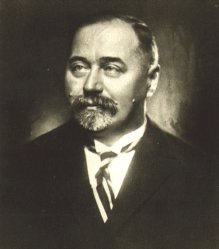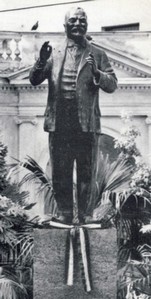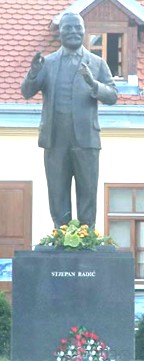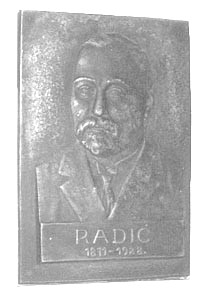The Russian branch of our Jelačić's Hrvatsko Kolo, Zagreb, 1909, p. 278-304. 
When you open the grand Russain Encyclopedicheskij slovar' [Encyclopedic dictionary] (ed. Brockhaus-Efron, St. Petersburg, 1894), you will find on p. 636 the following interesting lines: "A Croat Jelacic arrived to Russia around 1740. In 1742 he approached to the main St. Petersburg land hospital as a physician - practicioner, in a year he passed the exam for sub-physician, and just in the course of the next year he was a memeber of the physician's caravan expedition, which went to China, and where he was under way until 1747. In the beginning of 1754 a new caravan set off to China led by Vladikin, and Jelacic again escorted it as a physician, and besides this the St. Petersburg academy entrusted him to bring interesting books and materials from there, and the medicinal department asked to bring 1/4 pounds [weight] of the root called "zhen-shen" and to investigate properties of the corresponding plant. In Bejing Jelacic obtained 25 lots [weight] of "zhen-shen", but the leader of the caravan Vladikin took it away from him. Jelacic obtained excerpts from French and Portugese Jesuit descriptions of this root, which among others was described in Documents (Actes) of the French Academy already in 1718. Jelacic returned from this journey in 1756, and then started to work at the main Moscow hospital as an operator. In 1754, by a "Siberian rescript," a new caravan to China was organized and Jelacic was again appointed to escort it. He returned in 1764, after which he became the operator at the main St. Petersburg hospital at land military..." The name of this Jelacic was Franjo Luka, and he was educated at Viennese Jesuits, from where he escaped to Russia. One of his descendants, Franjo Josipovic Jelacic, was a famous surgeon (1808-1888) and as a university professor of Kazan has a great merit for founding the Kazan clinic, as we learn from the same encyclopedia. As soon as this Franjo Jelacic married with a Pravoslav Russian, he accepted pravoslav faith (according to the laws of the time), and until that time our Jelacic's were Catholics. The son of Franjo - Aleksandar Francevic Jelacic, was a famous lawyer and the head of exceptionally respected and educated family of Russian Jelacic's. He had five grown up sons, and two of them were distinguished with their literary and educational work. Russian Jelacic's preserved their Croatian traditions, and they are especially proud of their famous ban [viceroy] Jelacic. They sojourned already in Opatija, and also visited Zagreb, and of course, the Jelacic monument [on the Zagreb main square] in the first place. Aleksandar Jelacic is a liberal of English character, as was the case with almost all Russian thinkers in the 60s of the last [19th] century. Their sons belong to different political camps, but all of them are very important and extraordinarily educated people. 1. MIHAJLO JELACIC: THREE DRAMAS The third son of Aleksandar Jelacic, Mihajlo, became reputed after his three theatric pieces: "Duke's palace," "Expropriation," and "Burnt vessels." [^1 M.A. Jelachich': Knyazhij dvor'. Ekspropriaciya. Sozhzhennye korabli. str 255. - ...S. Petersburg'. 1909. T-vo Hudzhestv. pechati. C. 2 Rub.] All these three dramas were published in the beginning of 1909, all of them deal with the most recent questions of the Russian contemporary life, all of them are written with great mastery from dramatists point of view, and all of them are very important for knowing contemporary Russia. In all of these works also author's thinking about important questions is reflected, and therefore they represent a valuable source of information about Mihajlo Jelacic and the whole noble Croato-Russian family. It would be valuable and necessary to see all three dramas also on Croatian stages, and its Croatian translation would be a contribution to Croatian drama literature. Our writers would find immediately a rare ideal, which would be much inspiring than nonslavic dramas. Now let us see in passing the content of these three dramas, and then let us translate literally several passages that reflect contemporary situation in Russia, as well as the view of the writer. [...Here we skip more than 20 pages...] 2. EVGENIJ JELACIC [p. 301] I do not know Mihajlo Jelacic personally. He lives far away from St. Petersburg, somewhere in the Samara gubernia [region] below Kazan, on the estate of his father. It seems that he was very unhappy in his life, and experienced a lots, and probably that is why he is such a deep psychologist. His younger brother Evgenij, at least as I used to know him, is a pure bliss and happiness. Everything that I read and hear about the influence of the spirit on human body, how wise ideas reflect on countenance, and how inner happiness transforms a human being - all this I saw at Evgenij Jelacic with my own eyes. The first time I met him was on his lecture delivered in a large hall, called "Solyanoj gorodok" [Solty town], where he spoke with such easiness about difficult question, about homeland of a man of the north, as if he tells us a magic eastern story. He had two lectures, both about two hours, with a 15 minute pause, and there was no any listener with expression of boredom on his face, and one could hear nothing but praise and expressions of satisfaction. The Russian community can be rightfully proud of such a lecturer. Only since recently Evgenij Jelacic is more than thirty years old, but he is so deep in some branches of natural sciences, and carefully follows newest achievements in this field, so that in some areas he is already an authority. In any case, he represents a scientific poplarizer that I had no opportunity to either see or hear. Evgenij Jelacic works continuously and indefatigably on a question related to Ambulant Museum of Teaching. At first he had only several teaching instruments, that were circulating between several St. Petersburg teachers, deeply involved in intuititve instruction. Now this has become a large collection of thousands and thousands of teaching instruments, situated in a special building, systematically classified, which is continuously growing and improving, and being used far outside St. Petersburg. What is most important, this ambulant museum in St. Petersburg has become a center of about a hundred of similar regional museums, and besides this it supplies more and more primary schools with various teaching aids, starting with huge wall illustrations, to very rare animal preparations. To this end a museum has its own workshop and many lecturers, which work with apostolic zeal and dedication. Among them is also Evgenij Jelacic, in the first lines. It is a great pleasure to see him and hear him, when he shows you one room after another in the museum, and when each object is being revived not only with his thorough knowledge, but also with his inexhaustible enthusiasm. You really feel that his enthusiasm is of divine origin, since only due to this supernatural force is it possible to obtain with so modest means such great successes. Evegenij Jelacic is the same also in his apartment. Everything recalls his educative work and as soon you start to discuss with him about this, he is no more a meagre man, with untidy beard, and often with more than usual dresses. And when he sits, and especially when he stands up, and while speaking walks into his workshop, it seems as if he grew up, and his whole figure is flooded with an extraordinary ecstasy from his glowing eyes and enthusiasted soul. Besides his study of natural sciences and besides his work on ambulant museum, Evgenij Jelacic is also occupied with writing for children, and especially for youngest children. [Now follows one page describing his books and booklets for children, 1p] So, why to count all these books, since it would be more useful to read or at least to examine this whole little library of natural sciences, which we, the Croats, have so much neglected, and which can be seen on every step. With the breadth and depth of his education, with his enthusiasm for educational work among larges and most neglected masses of workers and peasants, with easiness of his narration and with his industriousness, Evgenij Jelacic is without any doubt such a cultural phenomenon which leaves deep traces even in a big nation, and for a small people he would create a new educational epoch. Let us hope that the youngest Jelacic, who is an enthusiasted pupil of his brother Evgenij, will pay a visit to his old motherland first of all at its University, and than also serve his little Croatia, in the region where so many Slavs carried their talents away into foregin lands that are even more developed after all. This paper of Stjepan Radic was brought to our attention by professor Gordana Linke, Zagreb Translated from Croatian by Darko Zubrinic (1999).

Mila Wood (1888-1968), created the monument of Stjepan Radic in 1929. The monument was placed on the main square in Petrinja (south of Zagreb) in 1936. The communist officials moved it from the main square, called the Radic Square, to the city parc, and during the 1991 Homeland War the monument has been destroyed and thrown into an orchard in the village of Cuncic. In 1998 the monument was discovered and transported into the iron foundry of works of art at the Academy of Fine Arts in Zagreb, where it has been renewed by means of a plaster copy from the Glyptotheque of the Croatian Academy of Sciences and Arts. Radic's monument has been placed again in Petrinja on December 28th, 1999. 
Original text in Croatian: Mila Wood je izradila kip Stjepana Radica godine 1929. Spomenik je prvi put na petrinjskom trgu postavljen 1936. Komunisticke vlasti su 1963. maknule spomenik s glavnoga trga koji je nosio Radicevo ime u gradski park, a u Domovinskom ratu 1991. spomenik je uništen i bacen u vocnjak u selu Cuncicu. Godine 1998. spomenik je pronaden i prevezen u ljevaonicu umjetnina na Akademiji likovnih umjetnosti gdje je obnovljen uz pomoc gipsanog otiska koji se nalazi u gliptoteci HAZU-a. Radicev spomenik je ponovno postavljen u Petrinji dne 28. prosinca 1999. Source 
Mila Wood (1888-1968) also created a plaque of Stjepan Radic (1871-1928), which has been kept in the Museum of the town of Ilok. The plaque has been stolen from the museum during the Greater Serbian occupation of the town (1991-1997). Source For additional information about the Russian branch of the Jelacic family see Tatjana Puskadija-Ribkin: Emigranti iz Rusije u kulturnom i znanstvenom zivotu Zagreba, Prosvjeta, Zagreb 2006
Jelacic family (in French), written by Michel Iellatchitch, France Source: www.croatianhistory.net
|